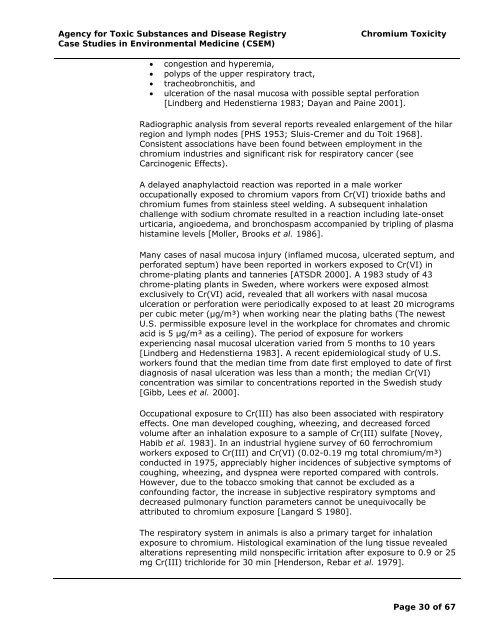(Cr) Toxicity | ATSDR - CSEM - Agency for Toxic Substances and ...
(Cr) Toxicity | ATSDR - CSEM - Agency for Toxic Substances and ...
(Cr) Toxicity | ATSDR - CSEM - Agency for Toxic Substances and ...
You also want an ePaper? Increase the reach of your titles
YUMPU automatically turns print PDFs into web optimized ePapers that Google loves.
<strong>Agency</strong> <strong>for</strong> <strong>Toxic</strong> <strong>Substances</strong> <strong>and</strong> Disease Registry Chromium <strong><strong>Toxic</strong>ity</strong><br />
Case Studies in Environmental Medicine (<strong>CSEM</strong>)<br />
• congestion <strong>and</strong> hyperemia,<br />
• polyps of the upper respiratory tract,<br />
• tracheobronchitis, <strong>and</strong><br />
• ulceration of the nasal mucosa with possible septal per<strong>for</strong>ation<br />
[Lindberg <strong>and</strong> Hedenstierna 1983; Dayan <strong>and</strong> Paine 2001].<br />
Radiographic analysis from several reports revealed enlargement of the hilar<br />
region <strong>and</strong> lymph nodes [PHS 1953; Sluis-<strong>Cr</strong>emer <strong>and</strong> du Toit 1968].<br />
Consistent associations have been found between employment in the<br />
chromium industries <strong>and</strong> significant risk <strong>for</strong> respiratory cancer (see<br />
Carcinogenic Effects).<br />
A delayed anaphylactoid reaction was reported in a male worker<br />
occupationally exposed to chromium vapors from <strong>Cr</strong>(VI) trioxide baths <strong>and</strong><br />
chromium fumes from stainless steel welding. A subsequent inhalation<br />
challenge with sodium chromate resulted in a reaction including late-onset<br />
urticaria, angioedema, <strong>and</strong> bronchospasm accompanied by tripling of plasma<br />
histamine levels [Moller, Brooks et al. 1986].<br />
Many cases of nasal mucosa injury (inflamed mucosa, ulcerated septum, <strong>and</strong><br />
per<strong>for</strong>ated septum) have been reported in workers exposed to <strong>Cr</strong>(VI) in<br />
chrome-plating plants <strong>and</strong> tanneries [<strong>ATSDR</strong> 2000]. A 1983 study of 43<br />
chrome-plating plants in Sweden, where workers were exposed almost<br />
exclusively to <strong>Cr</strong>(VI) acid, revealed that all workers with nasal mucosa<br />
ulceration or per<strong>for</strong>ation were periodically exposed to at least 20 micrograms<br />
per cubic meter (μg/m³) when working near the plating baths (The newest<br />
U.S. permissible exposure level in the workplace <strong>for</strong> chromates <strong>and</strong> chromic<br />
acid is 5 μg/m³ as a ceiling). The period of exposure <strong>for</strong> workers<br />
experiencing nasal mucosal ulceration varied from 5 months to 10 years<br />
[Lindberg <strong>and</strong> Hedenstierna 1983]. A recent epidemiological study of U.S.<br />
workers found that the median time from date first employed to date of first<br />
diagnosis of nasal ulceration was less than a month; the median <strong>Cr</strong>(VI)<br />
concentration was similar to concentrations reported in the Swedish study<br />
[Gibb, Lees et al. 2000].<br />
Occupational exposure to <strong>Cr</strong>(III) has also been associated with respiratory<br />
effects. One man developed coughing, wheezing, <strong>and</strong> decreased <strong>for</strong>ced<br />
volume after an inhalation exposure to a sample of <strong>Cr</strong>(III) sulfate [Novey,<br />
Habib et al. 1983]. In an industrial hygiene survey of 60 ferrochromium<br />
workers exposed to <strong>Cr</strong>(III) <strong>and</strong> <strong>Cr</strong>(VI) (0.02-0.19 mg total chromium/m³)<br />
conducted in 1975, appreciably higher incidences of subjective symptoms of<br />
coughing, wheezing, <strong>and</strong> dyspnea were reported compared with controls.<br />
However, due to the tobacco smoking that cannot be excluded as a<br />
confounding factor, the increase in subjective respiratory symptoms <strong>and</strong><br />
decreased pulmonary function parameters cannot be unequivocally be<br />
attributed to chromium exposure [Langard S 1980].<br />
The respiratory system in animals is also a primary target <strong>for</strong> inhalation<br />
exposure to chromium. Histological examination of the lung tissue revealed<br />
alterations representing mild nonspecific irritation after exposure to 0.9 or 25<br />
mg <strong>Cr</strong>(III) trichloride <strong>for</strong> 30 min [Henderson, Rebar et al. 1979].<br />
Page 30 of 67

















